
Cherry tree enthusiasts look forward to it each spring: a mass explosion of light pink blossoms. What’s not so exciting for lovers of the blossoms and their sweet fruit is the threat of cherry tree diseases. If you’ve noticed signs of disease, we’ve collected symptoms and causes for the seven most common cherry tree diseases and how to treat them.
Signs of disease can be frightening. These pathogens can harm an entire orchard of cherry trees, putting a full halt to any charming blossoms or juicy fruit. However, when cherry tree growers execute the right preventive measures, they decrease their trees’ susceptibility to infection and increase the chances of a vigorous bloom and delicious harvest.
1. Black Knot
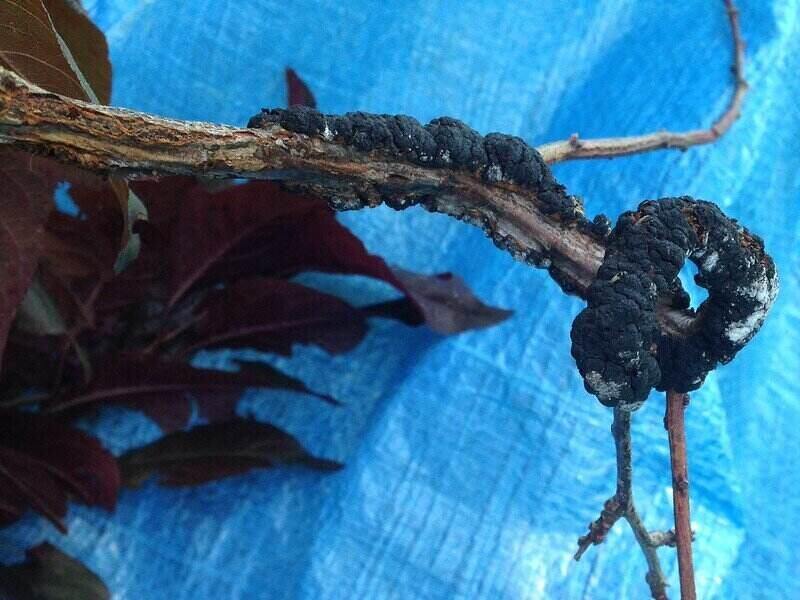
Cherry Trees Affected: A common ornamental cherry tree disease, black knot also affects most Prunus varieties, including edible and native types. Black knot-resistant cherry tree varieties include East Asian cherry, North Japanese hill cherry, and Prunus maackii (Manchurian cherry or Amur chokecherry).
Symptoms: Black knot (Dibotryon morbosum) appears as hard, black swellings or knots, which may stretch 1-6 inches on the tree. These knots appear in various areas around the tree and enlarge when the disease is left untreated.
Velvety, olive-green fungal growth may cover the knots. Diseased twigs often bend due to knot overgrowth. Infected branches may wilt, not grow leaves, and can eventually kill the entire tree.
Causes: Through spring and summer, mature knots produce spores. The rain and wind then carry the black knot fungus spores to susceptible plants.
The spores can germinate and infect new plants in six hours at the optimal temperature and wet conditions. By fall, light brown swellings appear on infected twigs. The following spring, the growing knots develop the olive-green fungal growth. As the year progresses into summer and fall, the knots become hard, rough, and black.
Treatment: Prune 3-4 inches below the knot during the dormant season. Sterilize all pruning equipment. Burn or bury all infected material; otherwise, it may still be able to infect healthy trees. Remove cherry trees that have a severe infection.
The Wisconsin Horticulture Division of Extension does not recommend using fungicides since treatment is expensive and likely to be ineffective.
Season: Infection occurs from April through June.
Risk: Black knot can limit the production of cherries and ruin the appeal of ornamental cherry trees.
2. Brown Rot
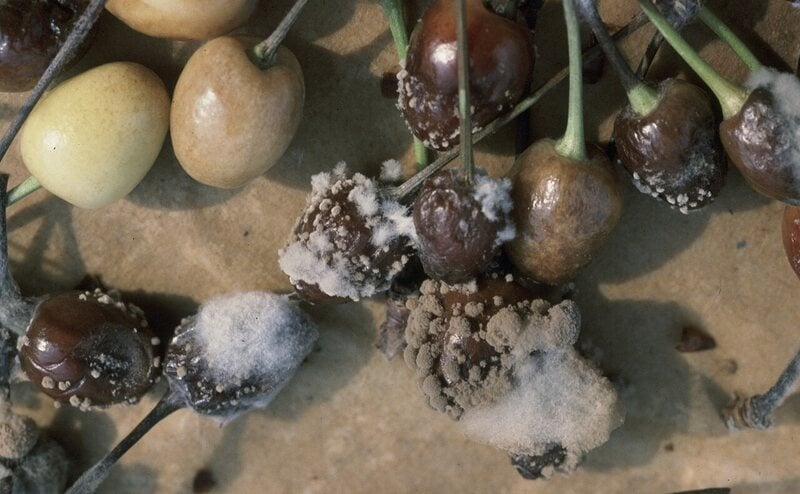
Cherry Trees Affected: Brown rot is a problem for the Kwanzan flowering cherry tree — as it is one of the most susceptible cultivars. It is also a common weeping cherry tree disease. Many stone fruits, including peach and plum trees, are also affected.
Symptoms: Brown rot (Monilinia fructicola) symptoms first occur as the browning of blossoms and the death of twigs. Leaves on the infected twigs turn brown and collapse but remain attached to the tree.
When wet weather conditions are right, powdery masses of brown-gray spores may be visible on infected fruits, flowers, or twigs.
Causes: If the infected blossoms do not drop off, the infection can spread from the flower to the neighboring twig. Twigs then develop cankers, which further produce fungal spores of the disease.
Brown rot thrives best in warm, wet conditions, causing infection to occur in as little as three hours. Insects can act as spreading agents for this fungal cherry disease.
Treatment: Once brown rot infects your cherries, there are no curable treatments for the fruit. Prune any affected parts of the tree with sanitized pruning tools 4 to 6 inches below the sunken dead tissue. Burn or bury the pruned materials to prevent the infection from spreading.
Thinning your fruit trees encourages airflow, allowing for a drier environment to deter the fungus. If brown rot is unmanageable and continues to infect your trees, consider using fungicides.
Season: Brown rot often attacks cherry trees when in bloom.
Risk: Cherry tree owners risk losing their fruit harvest to this disease.
3. Cherry Leaf Spot
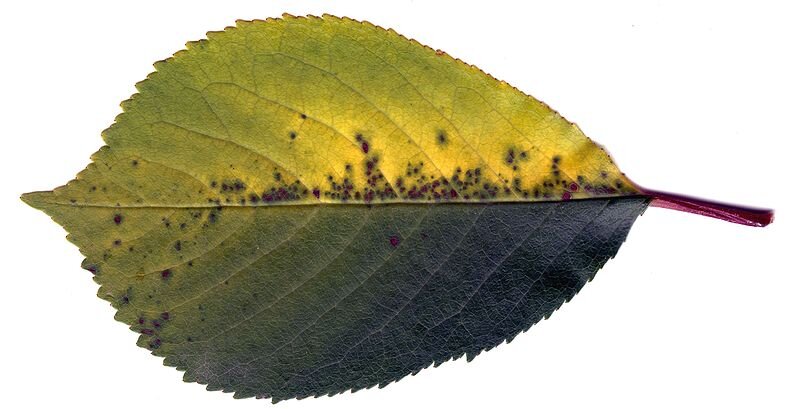
Cherry Trees Affected: Cherry leaf spot (Blumeriella jaapii) attacks tart, sweet, and English Morello cherries.
Symptoms: This disease affects the cherry tree leaves, and may appear on leaf petioles and fruit pedicels. Small purple spots develop on the upper side of the leaf. These spots will enlarge to approximately 1/4-inch in diameter and turn a reddish-brown color.
After six to eight weeks, the centers of the spots may dry up and fall out, creating small holes in the leaf. Sometimes older infected leaves may turn golden yellow before falling off. Cherry leaves infected with cherry leaf spot may fall prematurely. Do not confuse it for leaf scorch, which has similar symptoms: cherry tree leaves turning brown and curling instead of falling off.
Causes: This fungal disease overwinters in dead cherry leaves on the ground. In early spring, apothecia (fruiting bodies) develop on the leaves and produce spores. Rainfall spreads these spores to healthy leaves where the spores germinate and penetrate the leaf.
The small purple spots begin to appear on the leaf after infection. Once these spots have developed, their undersides create more fungal spores (conidia), which appear as whitish-pink underleaf lesions. Rain then spreads the conidia to other healthy cherry trees and creates new infections.
Treatment: Gather and destroy all fallen leaves to prevent the fungus from overwintering. Removing leaves is an effective solution for backyard cherry tree growing, but it has limitations for large cherry orchards. When planting your cherry tree, ensure to expose it to direct sunlight and good air circulation (pruning can achieve this).
In commercial orchards, fungicide is the best method to control the disease. The Ohio State University Extension recommends Bulletin 506 for commercial growers and Bulletin 780 for backyard cherry tree growers.
Season: The purple spots appear on cherry leaves between the end of May and the beginning of June.
Risk: A cherry tree with a severe infection may defoliate by mid-summer. Early and repeated defoliation may cause unripe fruit with poor taste. Cherry trees become more susceptible to winter injury, dead fruit spurs (fruit-bearing branches), loss of fruit, weak buds, and possible tree death.
4. Cytospora Canker
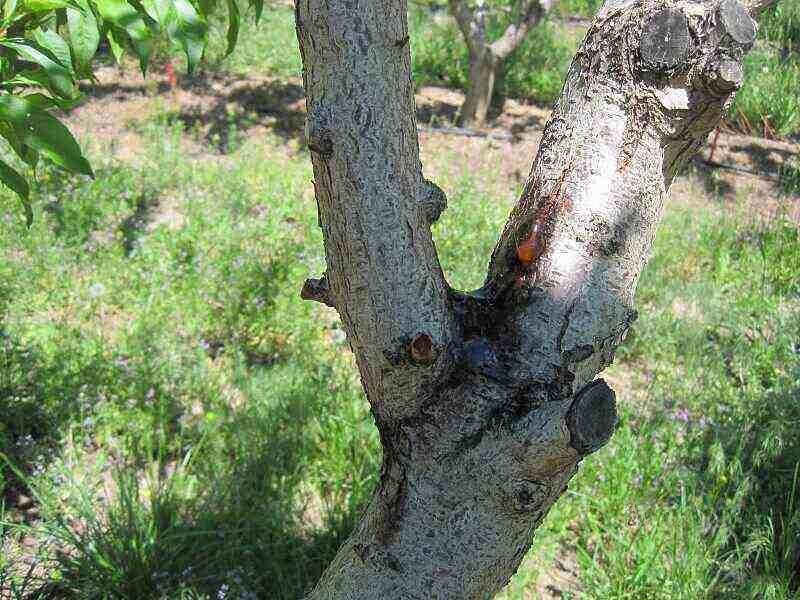
Cherry Trees Affected: Cytospora canker (Leucostoma kunze) is one of the most destructive diseases to sweet and sour cherries.
Symptoms: Cherry tree branches develop dark, depressed cankers that cause the tree branch to wilt. An amber-colored gum may appear at the edge of the canker. The canker will eventually girdle the limb and you’ll notice parts of the cherry tree dying.
Causes: Black pycnidia, spore-producing structures, appear on the canker. These black pycnidia will turn white over time. In humid conditions, spore masses expel from the pycnidia. Rain and wind carry the spores to infect any bark wound. These wounds may result from sunburn, old cankers, or wood-boring insects.
This disease cannot attack healthy, undamaged bark. A cherry tree’s susceptibility to Cytospora canker increases when it’s stressed from drought, nutrient deficiency (i.e. low potassium), overcropping, and ring nematodes.
Treatment: There is no chemical control for Cytospora canker. Control infection by limiting tree stress. Prune your infected cherry tree during the growing season when it’s easier to identify the cankers and limbs with dieback.
Season: Cytospora canker thrives in the summer when temperatures are above 90 degrees. Dead limbs girdled by cankers appear in mid to late summer.
Risk: Formed cankers will kill parts of your cherry tree.
5. Powdery Mildew
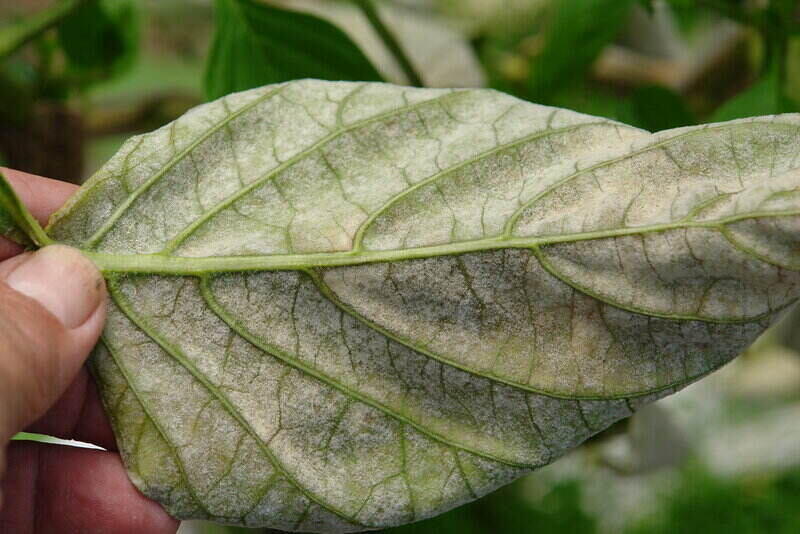
Cherry Trees Affected: Sweet and sour cherry trees are the most susceptible to powdery mildew (Podosphaera clandestina). Powdery mildew is also a common weeping cherry tree problem.
Symptoms: Light powdery patches appear on young cherry leaves. Older leaves are less likely to have powdery patches as they may have resistance to powdery mildew. Infected leaves may distort, twist, or grow pale. A white fungus may develop at the stem end of the cherry.
Causes: In the fall, small structures (chasmothecia) containing ascospores lie dormant in leaves or where tree limbs come together (crotches). During rainfall or irrigation, these structures release the ascospores. The wind carries the ascospores to infect young leaves.
By fall, the fungal infection enters its overwintering stage in the chasmothecia to repeat the cycle next season. This disease favors humid conditions and temperatures between 70 to 80 degrees.
Treatment: Avoid early irrigation as this may cause premature powdery mildew infections to rise. The ground should still be moist in the spring, and unnecessary watering may cause powdery mildew to begin infection. According to Washington State University, a two-week delay in irrigation can delay the disease with no negative impact on the fruit.
Pruning your cherry tree will encourage airflow and leaf dryness. If using fungicides as treatment, keep in mind that most fungicides are a preventive measure and do not cure the disease.
Season: Practice preventive management methods throughout the full fungal growing seasons in late summer and early fall.
Risk: Mid-and-late-season sweet cherries are commonly affected. Powdery mildew may ruin your cherry fruit with a white fungal growth on the cherry surface.
6. Necrotic Ringspot
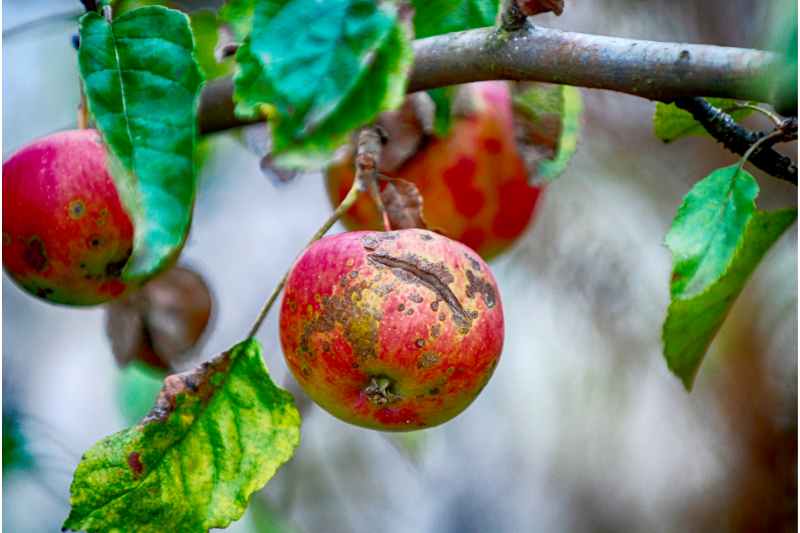
Cherry Trees Affected: Necrotic ringspot attacks sweet and sour cherries.
Symptoms: Symptoms include yellowing and browning of cherry leaves. Leaves develop holes, giving them a shothole appearance. Leaves may drop in early summer, and the cherry fruit may deform or mature later than usual.
The spread of this disease is much slower in sweet cherries than in sour cherries. Enations or raised projections will form on the underside of leaves, giving a thick and stiff appearance.
Causes: The virus, Prunus necrotic ringspot virus (PNRSV), spreads through pollen, seed, and wood grafting. Wind and pollinators can spread infected pollen throughout an entire orchard.
Treatment: Remove symptomatic trees to prevent spread to other cherry trees.
Risk: Necrotic ringspot may stunt your tree’s growth and kill its twigs, buds, and foliage. PNRSV can cause fruit losses of up to 15% in sweet cherries and up to 100% in peaches.
7. Silver Leaf
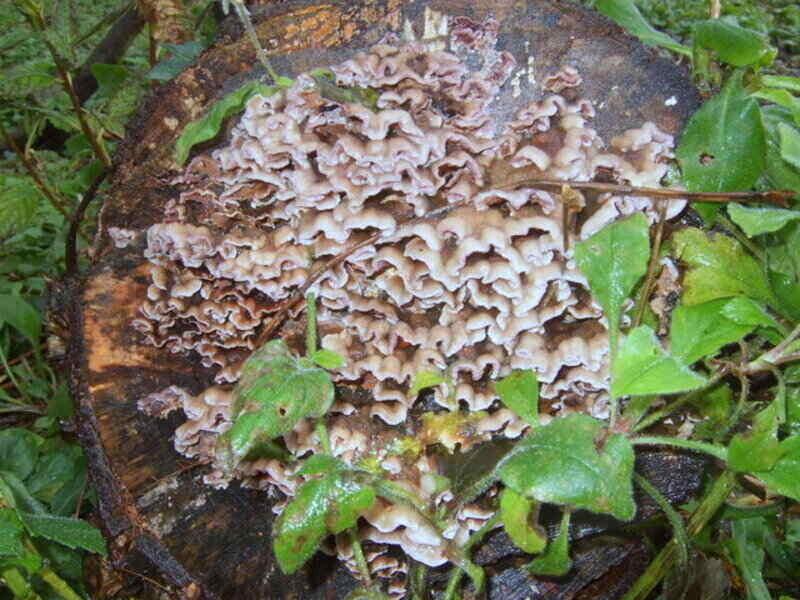
Cherry Trees Affected: Sweet and sour cherries are commonly affected by silver leaf.
Symptoms: The first symptom of silver leaf (Chondrostereum purpureum) is a silver sheen on the affected leaves. The precise number of leaves affected will vary from tree to tree. The silvery leaves may develop brown, dead patches, and leaf symptoms may not appear year after year.
If they appear one year, they may not reappear the next. Do not mistake the lack of symptoms for a full recovery. Branches with symptomatic leaves may have a dark stain running underneath them. In diseased trees, you may notice a white fungus on the cherry tree bark with noticeable purple-brown conks.
Causes: The conks are reproductive structures of the disease-causing fungus. The fungus is released from the conks during wet conditions in autumn and spreads and infects trees with open wounds. The fungus then lives in the water-conducting tissue of branches (xylem). Its presence in the xylem is what causes the dark stain.
The fungus releases a toxin, which then travels to the leaves and causes a silvery appearance. The epidermis (the surface layer) separating from the rest of the leaf blade causes the metallic sheen. This separation impacts the reflection of light. As the wood decays, the disease begins to develop the fungus-producing conks on the wood.
Treatment: Prune branches showing any leaf symptoms or signs of conks. Prune branches at least 4 inches below where staining and conks are visible. Mark your diseased trees. This way, when symptoms do not reappear the following year, you will know to pay close attention to that particular tree.
As the fungus limits water movement in branches, provide enough water, about 10 gallons of water for each inch of the tree’s diameter, for the diseased trees. No fungicides are available to treat this disease.
Season: Prune infected trees during dry winter periods when temperatures are below 32 degrees. Pruning at this time will help prevent the spread of silver leaf. If pruning in the growing season, ensure you are doing it in dry conditions.
Risk: Silver leaf will cause a slow decline in your cherry tree’s health and fruit yield.
FAQ About Common Cherry Tree Diseases
1. Why Are My Cherry Tree Leaves Turning Brown?
Cherry tree leaves usually turn brown from improper watering, weather stress, or cherry diseases such as cherry leaf spot or brown rot.
2. Why Is My Cherry Tree Losing Leaves In Summer?
High heat and drought can make leaves drop off as well as diseases like cherry leaf spot.
Extreme environmental factors can also be why some cherry trees are dying during spring: Prolonged spring rains can cause root damage, while very dry summers can cause water stress.
Additionally, rapid drops in temperatures during fall and late spring frost events can cause freeze damage. If one of these events is followed by another, it becomes increasingly harder for the tree to recover, causing it eventually to die.
3. What Are The Symptoms Of Cherry Tree Fungus?
It can vary based on the fungus. Black swellings or knots, silver leaves, light powdery patches, depressed cankers, and leaves falling off are all signs of a problem.
4. How Do I Sanitize My Pruning Tools?
Ethanol or isopropyl alcohol is ideal for sanitizing pruning equipment because blades can simply be wiped or dipped into disinfectant without a prolonged soak.
5. What Cherry Trees Are Black Knot-Resistant?
Black knot-resistant cherry tree varieties include East Asian cherry, North Japanese hill cherry, and Prunus maackii (Manchurian cherry or Amur chokecherry).
When to Call a Professional Arborist
Consulting a professional, licensed arborist near you is an essential first step to saving your cherry tree. If you notice any concerning symptoms in your cherry tree, call a tree care professional right away.
A certified arborist can apply treatments and remove infected trees. Arborists can even assist cherry tree growers before symptoms occur by performing preventive disease measures.
Main Image Credit: Karolina Grabowska / Pexels